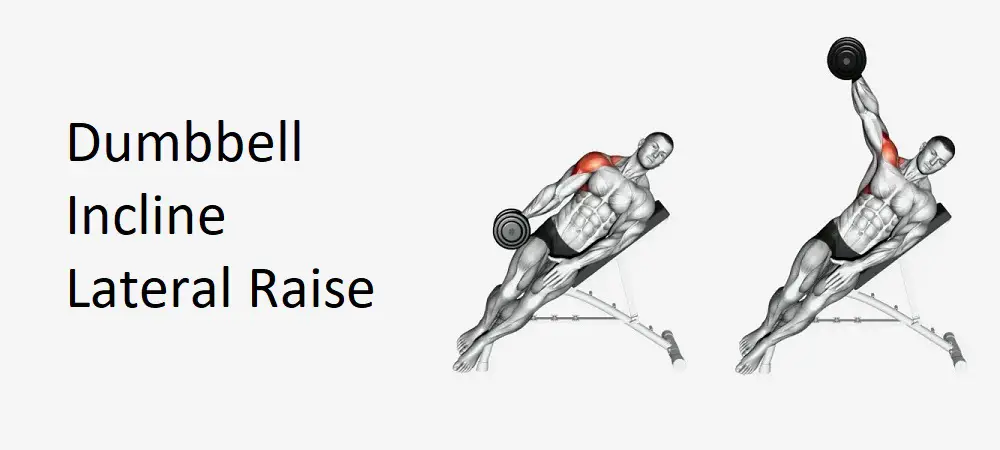Table of Contents
Introduction:
The Dumbbell Incline Lateral Raise is an isolation exercise that targets the lateral deltoid (side shoulder muscles), helping to develop shoulder width and definition. Unlike the standard lateral raise, the incline position minimizes the use of momentum and encourages better form, leading to more effective muscle activation. This exercise is particularly useful for individuals who want to create a broader shoulder appearance and enhance the strength and stability of their deltoids.
This movement can be included in shoulder workouts or upper body routines to develop a well-rounded and symmetrical shoulder profile.
Instructions: How to Perform Dumbbell Incline Lateral Raise
To perform this exercise correctly, follow these steps:
- Setup: Adjust an incline bench to a 45-degree angle. Choose a pair of light to moderate dumbbells that allows you to maintain proper form.
- Body Positioning: Sit on the incline bench sideways, with your torso angled toward the bench. Your chest should rest against the back of the incline bench, stabilizing your body and preventing excess swinging.
- Starting Position: Hold a dumbbell in each hand with a neutral grip (palms facing each other) and let your arms hang straight down, slightly in front of your body.
- Raise the Dumbbells: With a slight bend in your elbows, lift the dumbbells up and out to the sides until they are just below shoulder height. Your arms should form a “T” shape with your body at the top of the movement.
- Lowering the Weight: Slowly lower the dumbbells back to the starting position, maintaining control and keeping tension on your shoulders.
- Repetitions: Aim for 10–15 reps per set and complete 3–4 sets in total.
Pro Tips:
- Avoid swinging or jerking the weights; focus on smooth, controlled movements to maximize muscle engagement.
- Keep your torso stable against the bench to prevent engaging your lower back or core.
- Engage your shoulders fully and keep your elbows soft to protect your joints.
Benefits of Dumbbell Incline Lateral Raise
The Dumbbell Incline Lateral Raise provides several advantages that make it an effective exercise for shoulder training:
- Targets the Lateral Deltoid: This exercise isolates the lateral head of the deltoid, helping you achieve broader, more defined shoulders.
- Minimizes Momentum: The incline bench position limits the use of momentum, ensuring that your shoulders do the majority of the work and leading to better muscle activation.
- Improves Shoulder Symmetry: By working each arm individually, this exercise can help correct any strength imbalances between the left and right shoulder muscles.
- Reduces Stress on Lower Back: The incline position removes pressure from the lower back, making it a great choice for individuals with back issues who still want to work their shoulders effectively.
- Builds Shoulder Stability: Strengthening the lateral deltoid helps stabilize the shoulder joint, which is beneficial for other compound exercises like shoulder presses and bench presses.
- Enhances Upper Body Aesthetics: Defined lateral deltoids contribute to a V-tapered physique, making the upper body appear broader and more symmetrical.
Muscles Worked in Dumbbell Incline Lateral Raise
This exercise primarily targets the lateral deltoid but also engages other stabilizing muscles:
- Lateral Deltoid: The primary target, responsible for shoulder abduction and helping create shoulder width.
- Supraspinatus: Part of the rotator cuff, this muscle aids in shoulder abduction and helps stabilize the shoulder joint.
- Upper Trapezius: The traps help stabilize the shoulder blades, particularly as the arms reach shoulder height.
- Core Muscles: Although minimally, the core is engaged to stabilize the body against the incline bench.
Video on How to Do Dumbbell Incline Lateral Raise
Other Names for Dumbbell Incline Lateral Raise
The Dumbbell Incline Lateral Raise may be known by other names, depending on the gym or equipment used. Common alternatives include:
- Incline Dumbbell Side Raise
- Incline Lateral Raise
- Incline Shoulder Lateral Raise
No matter the name, this exercise provides the same benefits for lateral deltoid development.
FAQs
1. Can beginners perform the Dumbbell Incline Lateral Raise?
Yes, beginners can perform this exercise. Starting with light weights is recommended to ensure proper form and gradually increase as they become comfortable with the movement.
2. How does the Dumbbell Incline Lateral Raise compare to a standard lateral raise?
The incline position minimizes momentum and isolates the lateral deltoid more effectively than the standard version, which can sometimes involve other muscle groups if done with poor form.
3. Should I use heavy weights for this exercise?
Since this exercise targets a smaller muscle group, it’s best to use a moderate weight that allows for controlled, high-quality reps. Heavy weights can increase the risk of shoulder strain and compromise form.
4. How often should I include the Dumbbell Incline Lateral Raise in my workout?
Include it 1–2 times per week as part of a comprehensive shoulder routine. Pair it with compound shoulder exercises to achieve balanced development.
5. Is it okay to perform this exercise seated instead of using an incline bench?
While you can perform it seated, the incline bench setup provides better support and minimizes momentum, leading to more effective isolation of the lateral deltoid.
Conclusion
The Dumbbell Incline Lateral Raise is a fantastic addition to any shoulder workout. By positioning your torso against an incline bench, you eliminate momentum and focus purely on the lateral deltoid, maximizing shoulder activation and strength. This exercise is highly effective for developing broader, well-defined shoulders and promoting a balanced, symmetrical upper body.
Incorporate the Dumbbell Incline Lateral Raise into your shoulder routine 1–2 times per week to build strength, stability, and aesthetics in the shoulders. With consistent practice, you’ll notice improved definition and symmetry in your shoulder muscles.








